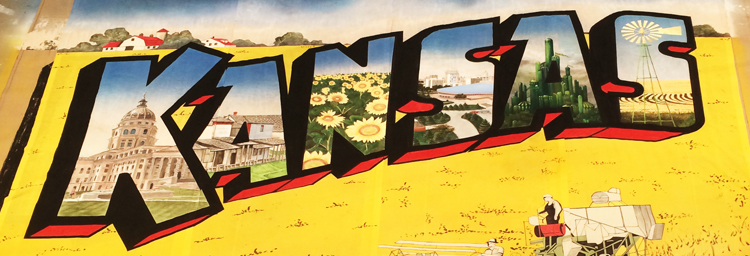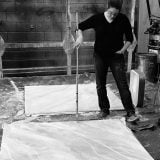Mikah Berky, the Assistant Scenic Charge at the Oregon Shakespeare Festival, recently needed to paint some large backdrop panels out of china silk for their production of “The Wiz.” She needed to find a paint that would allow her and her crew to “paint in the same way they were used to painting as scenic artists,” while providing them with art that would survive in the elements and maintain the “flowy-ness” of the delicate fabric. Watch the video and read-on below to find out from Mikah herself how Rosco Supersaturated Scenic Paints proved to be the solution she needed to meet this challenge!
We got the paint elevation for what seemed like a fairly straightforward backdrop for Oregon Shakespeare Festival’s production of The Wiz designed by Christopher Acebo. At least, it seemed straight forward until I learned that the backdrop was made up of four panels of thirty-foot china silk that needed to overlap to form one image. The image was a somewhat stylized postcard that said “Greetings from Kansas,” but inside each letter of Kansas was a nearly photo realistic image. That, my friends, is the China Silk Challenge: How to paint realistic scenery on a drop that would live outdoors while maintaining the flowing quality of the silk.
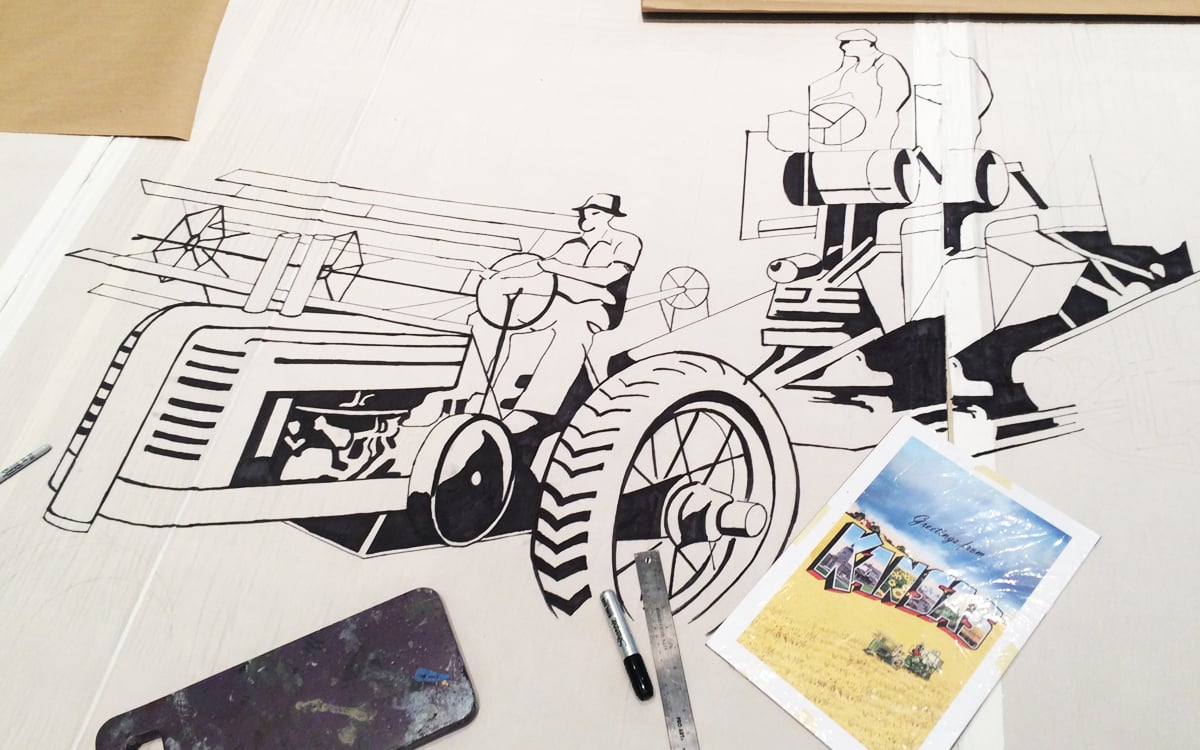
Needless to say, our shop started doing lots of samples. We tried lots of different products in many different combinations. Since The Wiz was playing in our outdoor theater, we needed a product that would withstand exposure to rain. From the outset, I was really hopeful that Rosco’s supersaturated paint would give us the best result by allowing for layering while maintaining the flowing texture of the silk. But, before we settled on a choice, I wanted to make sure we explored all of our options.
 We considered dye because it would have the softest finish, but I didn't think we could achieve the level of detail that the drop required using only dye. We sampled Dye-Na-Flow, a product made by Jacquard, but it did not layer the way we needed. We tried Liquitex and Montana acrylic paint markers, thinking that maybe we could use them in combination with dye on the smaller more detailed areas, but they washed out too easily.
We considered dye because it would have the softest finish, but I didn't think we could achieve the level of detail that the drop required using only dye. We sampled Dye-Na-Flow, a product made by Jacquard, but it did not layer the way we needed. We tried Liquitex and Montana acrylic paint markers, thinking that maybe we could use them in combination with dye on the smaller more detailed areas, but they washed out too easily.
Ultimately, after all the sampling, Rosco’s Supersats were the best option. They allowed us to paint the way that we were used to painting as scenic artists, with the ability to layer colors to achieve detail. The silk stayed flexible and flowing with very little stiffness, and the paint held up to our water test – with nothing washing out. The only problem we encountered was that the paint had a tendency to bleed a little if applied too heavily. After doing a few more samples, we discovered that laying the silk over bogus paper seemed to help wick the excess paint and prevent some of the bleeding.
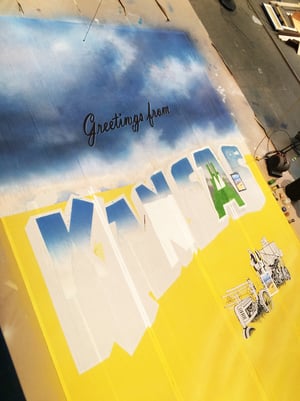 To lay out the project, we decided to staple the silk panels to the paint deck. Stapling it directly to the deck was important so the silk would lay directly on top of the bogus paper. It also was the fastest method and allowed us to easily match up the overlapping image on the edges of each panel. To begin, we printed out a full size black and white image for each panel, placed it under the silk and traced the image with pencil. We removed the paper printout, masked off everything that was not part of the sky, and painted the sky using a combination of HVLP sprayers, Hudson sprayers, and some brush work. Once the sky was finished, we masked it off to paint the wheat field using HVLP and Hudson sprayers with some brush work. The image of the men on the tractor was done almost entirely with sharpies. With the two large areas done, we moved on to the interior detail of the letters and the small details at the horizon, using brushes and sharpies. Finally, we filled in the black and red outline of each letter and called it done.
To lay out the project, we decided to staple the silk panels to the paint deck. Stapling it directly to the deck was important so the silk would lay directly on top of the bogus paper. It also was the fastest method and allowed us to easily match up the overlapping image on the edges of each panel. To begin, we printed out a full size black and white image for each panel, placed it under the silk and traced the image with pencil. We removed the paper printout, masked off everything that was not part of the sky, and painted the sky using a combination of HVLP sprayers, Hudson sprayers, and some brush work. Once the sky was finished, we masked it off to paint the wheat field using HVLP and Hudson sprayers with some brush work. The image of the men on the tractor was done almost entirely with sharpies. With the two large areas done, we moved on to the interior detail of the letters and the small details at the horizon, using brushes and sharpies. Finally, we filled in the black and red outline of each letter and called it done.
This was one of those projects that the planning and sampling were crucial and took almost as much time as actually painting it. Due to the nature of the silk and the nature of the paint we used, it would have been really difficult to paint over mistakes. I held my breath a bit through the process, knowing how easy it would be to mess up the drop, but in the end, the preparation paid off and helped us finish the project without any major problems. A big thanks to the other scenic artists who worked on this project: Gabriel Barerra, Amanda Haverick, and Sandy Phillips.
To see more of Mikah Berky’s scenic art, be sure to visit her website. If you’d like to learn more about the scenic paint products that Mikah used in the Oregon Shakespeare Festival’s production of “The Wiz,” you can explore the Rosco Supersaturated Product Page.
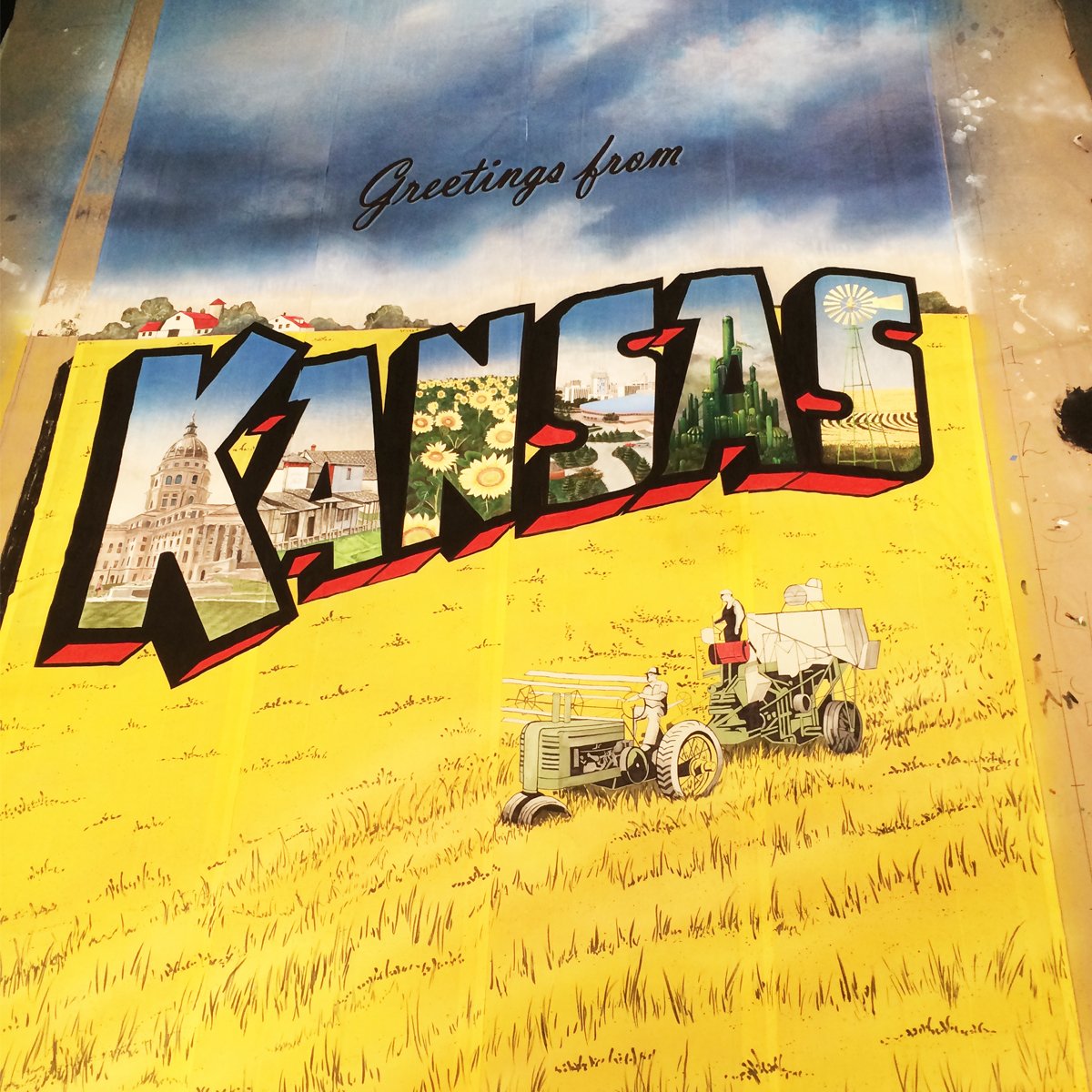
Save
Save
Save

